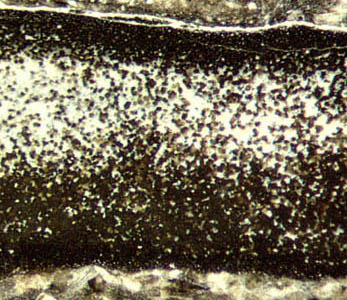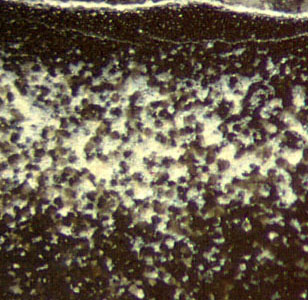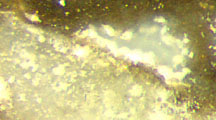A Devonian plant that would not fit in
Fossil finds which do not seem to fit to known species are not uncommon
and keep the palaeontologists wondering. Most often it is found out
where they fit in after all, otherwise they may indicate the presence
of something
new. Really intriguing are the nematophytes, which have got
names but have not yet got a branch on the Tree of Life. The
Lower Devonian Rhynie chert has provided some, including new
ones. The Rhynie chert is expected to yield more surprises, and here is
another one which awaits interpretation.

Fig.1: Unknown fossil in Rhynie chert with granular aspect. Width of
the picture 9.5mm.
Fig.2 (below): Detail of Fig.1. Width of the picture 1.5mm.


Fig.3 (left): Angular grains of unknown origin, detail
of Fig.1. Width of the picture 0.83mm.
The
plant or plant parts presented here look like a bag filled with grains
(Figs.1,2).
Their partially straight contours could be crystal faces or replicas of
plane cell walls. Apparently, silicification has produced quartz powder
in addition to the compact grains, providing good optical contrast.
The dark grains
show a slight tendency of being arranged in chains, as seen
in Fig.3 at
some place on
the right, for example. This indicates that a process spreading from
cell to cell
may have affected the silification of the interior. Phenomena of
such kind, perhaps mediated by some rot fungus, have
produced the cell-size clots or angular grains repeatedly
misinterpreted as mite coprolites.
The grain size of 20...35Ám
is smaller than the cell sizes of any
of the 7 vascular plants hitherto discovered in the Rhynie chert, and
also smaller than the "coprolites"
found in
petrified wood.
The
black appearance is brought about by two effects: The transparent
grains let the light pass into depth and therefore look much
darker
than the white powdery quartz, and some have
black
inclusions of decayed organic matter. Near the surface of the grain bag
the dark grains are so crowded
that one cannot see whether or not the plant had an epidermis.
 There
is a small spot of decayed and vanished tissue where the former surface
is faintly indicated by a thin dark line (Fig.4). Such line
is also
seen in some places on the other half of the cut specimen. The thin
lines along parts of the contour might be the remains of a
cuticle on an epidermis.
There
is a small spot of decayed and vanished tissue where the former surface
is faintly indicated by a thin dark line (Fig.4). Such line
is also
seen in some places on the other half of the cut specimen. The thin
lines along parts of the contour might be the remains of a
cuticle on an epidermis. 
Fig.4 (left): Cuticle (?) seen as a dark line covering
a hole under the surface (below left in
Fig.1).
Fig.5 (right): Squeezed end of the bag in Fig.1 or end of stalk with
holdfast ? Width of the picture 0.7mm.
There
is one feature in Fig.1 which is either highly significant or a mere
artefact due to partial decay and compression: The bag of more than 1mm
thickness suddenly narrows into an indistinctly seen
extension to the right, poorly silicified and traversed by
cracks. It resembles a stalk with a (tripartite
?) foot or holdfast, width 0.6mm, at its end (Fig.5).
As the bag is also seen on the other side of the cut gap
of 1mm or more, and with the
surfaces of the halves standing nearly perpendicular on the cut
faces, one can conclude that what
is seen in Fig.1 is a lengthwise section of a bag of little more than 1mm
thickness and at least 3mm width. If the narrow extension really were a
stalk, it would be ribbon-like.
The fact that no
indication of vascular tissue is seen on either half of the divided bag
does not mean
there is none but it suggests that possibly there is none.
The absence of hyphae and tubes excludes any affiliation
with fungi or
nematophytes. The presence of a cuticle (Fig.4) does not necessarily
indicate a land plant. Organisms living in an
aquatic
habitat which repeatedly falls dry may develop a cuticle, as it is
known from nematophytes. The habitat
which turned into the Rhynie chert
by silicification harboured aquatic and subareal plants,
fungi,
and creatures.
At a vertical distance of about 3cm below Fig.1, lots of squeezed and a
few well
preserved Rhynia
sections are seen, together with several charophyte specimens
resembling Palaeonitella,
indicating subaerial and submerged conditions at times.
A plant with bag-like body, stipe, and holdfast suggests
comparison with the recent Brown Alga Laminaria. The
comparison leads to a bigger and a smaller problem: This fossil is more
than twice as old as the allegedly first Brown Algae [1].
Hence, there must have been algae with the aspect of Brown Algae long
before, which poses the problem of where to place them on the
phylogenetic tree.
The fact that this alga had lived in the
Devonian freshwater-dominated habitat at Rhynie does not preclude an
interpretation as a precursor of Brown Algae
since
it is known that among the numerous extant Brown Alga species there
is
a
small fraction of freshwater species [2]. This
small alga could have been a freshwater
Brown Alga of its time,
which would be the only one found hitherto.
Although a final interpretation of the fossil
has to be left to those
who
might find more specimens of this kind sometime or perhaps have a
bright idea just now, a few tentative conclusions suggested by the
observations have been presented here.
Sample: Rh22/1 (0.21kg), found by Sieglinde Weiss at
Castlehill in 2009.
H.-J.
Weiss
2013, modified in
2021
[1] Th. Silberfeld
et al.: A multi-locus
time-calibrated phylogeny of the brown algae
... Molecular Phylogenetics and Evolution 56 (2010) 659–674.
[2] J.D. Wehr:
Freshwater Algae of North America, Chapter 19,
Brown Algae, 2014, Acad. Press.
 |
 |
50 |





 There
is a small spot of decayed and vanished tissue where the former surface
is faintly indicated by a thin dark line (Fig.4). Such line
is also
seen in some places on the other half of the cut specimen. The thin
lines along parts of the contour might be the remains of a
cuticle on an epidermis.
There
is a small spot of decayed and vanished tissue where the former surface
is faintly indicated by a thin dark line (Fig.4). Such line
is also
seen in some places on the other half of the cut specimen. The thin
lines along parts of the contour might be the remains of a
cuticle on an epidermis. 

